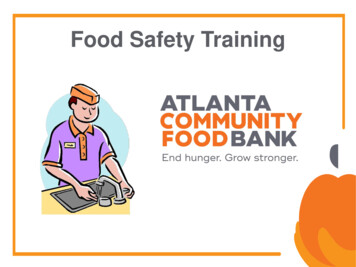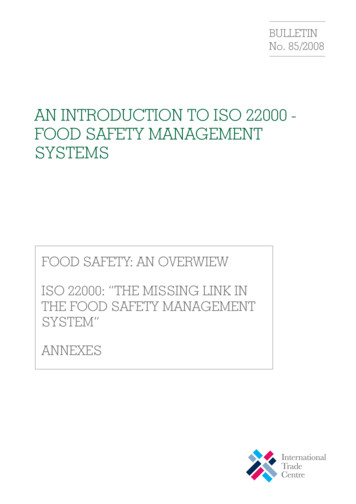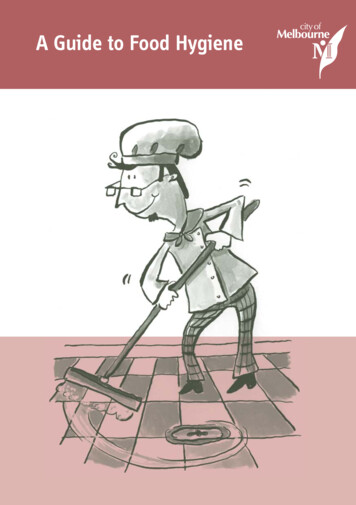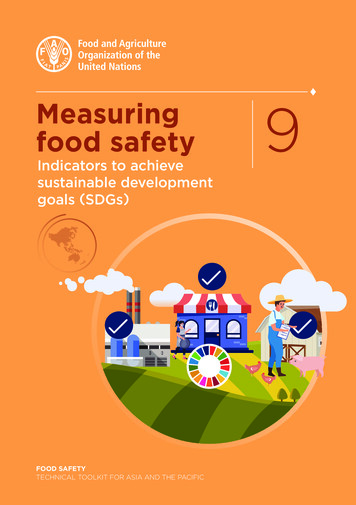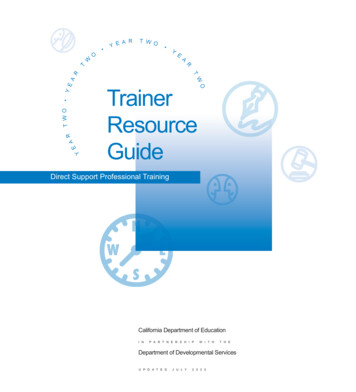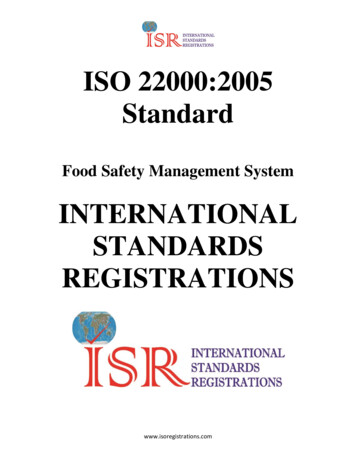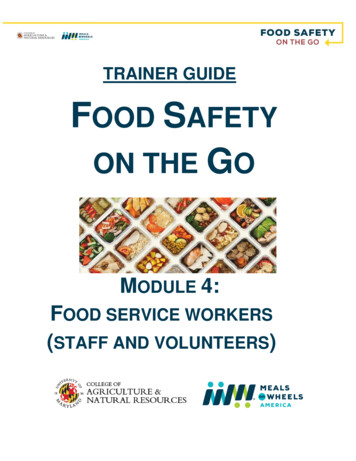
Transcription
TRAINER GUIDEFOOD SAFETYON THE GOMODULE 4:FOOD SERVICE WORKERS(STAFF AND VOLUNTEERS)
2019 EDITIONTable of ContentsINTRODUCTION1TRAINING GUIDELINES2Recommended facilities and materials2Activities3Evaluations3Training tips3MODULE 4 - FOOD SERVICE WORKERS3(STAFF AND VOLUNTEERS)3Length3Purpose31. Food service workers need to be in good health and maintain good personalhygiene62. How to handle food safely10KEY POINTS13ACTIVITY: What’s wrong with this picture?13MORE INFORMATION16GLOSSARY17FOOD SAFETY WEBSITES19INTRODUCTION“Food Safety on the Go” is a food safety training program for staff, volunteers andclients of home-delivered meal programs. It is made up of 6 modules. Module 1, Foodsafety basics, is an overview of food safety for all staff and volunteers. Modules 2through 5 are for specific individuals within a program: Module 2 is for the programdirector, Module 3 is for the food service management staff, Module 4 is for food serviceworkers (staff and volunteers), and Module 5 is for drivers (staff and volunteers).Module 6, which is for clients, is in the form of magnets for drivers to give to clients.1
Module 1Food safetybasicsModule 2Program directorModule 3Food servicemanagement staffModule 4Module 5Food service workers(staff and volunteers)Drivers (staff andvolunteers)Module 6Clients (education)Food service workers should complete Module 1, Food safety basics, and Module 4,Food service workers.Thank you for participating in the “Food Safety on the Go” training program.TRAINING GUIDELINESRecommended facilities and materials Meeting roomComputer with Microsoft PowerPoint softwareProjector and projection screen (or wall)PowerPoint files for the relevant modules (for the trainer)Trainer Guides for the relevant modules (for the trainer)Course Books for the relevant modules (one for each participant)Pre-tests and post-tests (one of each for each participant, for each relevantmodule) Pens/pencils (one for each participant)2
ActivitiesAn activity is included at the end of each module to help reinforce participants’knowledge of the material.EvaluationsA pre-test is given to participants at the beginning of each module, and a post-test atthe end of each module, to help determine how useful the module is and whatparticipants have learned.Training tips If possible, set up the training area at least a half hour before the trainingsession. Make sure that the equipment is working properly, and that all materialsand supplies are ready. Prepare for the training session by reviewing the information in the trainerguide(s). Encourage participants to share their experiences and to ask questions. If possible, try to illustrate some points with your own experiences. Allow time for breaks if needed. Ask participants to turn off their cell phones during the training session. If you have time at the beginning of the training session, you can try to assessparticipants’ food safety knowledge by asking them if they have had food safetytraining, and if so, how much training. It can help to have an idea of the level offood safety knowledge of participants.MODULE 4 - FOOD SERVICE WORKERS(STAFF AND VOLUNTEERS)Length 30 minutesAudienceThis module is for food service workers, both staff and volunteers, of a home-deliveredmeal program.PurposeThis module discusses the food safety responsibilities of food service workers in ahome-delivered meal program.3
Trainer note: Welcome participants, introduce yourself and have participants introducethemselves. Explain that “Food Safety on the Go” is a food safety course for home-deliveredmeal programs.Trainer: Go to slide 1.Trainer: Go to slide 2.4
Trainer: Go to slide 3.Trainer note Explain that you will give participants a page with a few questions (pre-test) to try toanswer as best they can before the module, and then again after the module (posttest). Let them know that it will take about 5 minutes each time. Hand out the pre-test, and pens or pencils if needed. Give the participants 5 minutesto answer the questions, and collect the pre-tests.5
Trainer: Go to slide 4.1. Food service workers need to be in good health and maintain good personalhygienea. Symptoms and illnesses of concernHome-delivered meal clients are at high risk of foodborne illness. To preventfoodborne illness, staff and volunteers who handle food need to be in goodhealth. People who are sick and who work with food can transfer harmful virusesand bacteria to food, which can lead to foodborne illness in clients. They canalso transfer harmful viruses and bacteria directly to other staff members orvolunteers, who can then become sick. If someone who handles food isdiagnosed with a foodborne illness or shows any of the following symptoms, heor she should report this to the food service management and be excluded fromworking: vomiting diarrhea jaundice (yellowing of the skin and eyes) sore throat with fever6
Trainer: Go to slide 5.Also, any wounds on hands or arms should be covered with a clean, dry,impermeable bandage that keeps the wound from leaking. Bandages on handsshould also be covered with disposable gloves.Trainer: Go to slide 6.b. Washing handsWashing hands is one of the best ways to reduce risk of foodborne illness, as itdecreases the spread of harmful viruses and bacteria. Up to 80 percent of allinfections are transmitted by hands, and harmful bacteria and viruses cansometimes survive on unwashed hands for hours.Trainer: Go to slide 7.7
Hands should be scrubbed in warm soapy water for at least 20 seconds beforeand after handling food, after using the restroom, and after touching one’s hair,face, body, clothing, or anything else that could contaminate hands. Handsshould be dried with a clean paper towel or a hand dryer.Trainer: Go to slide 8.c. Personal hygienePoor personal hygiene is a common cause of foodborne illness. Food serviceworkers need to have good personal hygiene so that they do not spread harmfulviruses or bacteria to food or to other people. They should keep their fingernailsshort and clean, bathe or shower before working with food, and keep their hairclean. They should also wear clean clothes and a clean hair restraint whenworking with food. If food service workers wear aprons and leave a foodpreparation area, to go to the restroom for example, they should take off theiraprons and store them properly before going. Food service workers shouldremove any jewelry from their hands and arms before working with food. Theyshould not eat, drink, smoke, or chew gum or tobacco while handling food or8
while working in a food preparation area. They should also minimize talking ifthey do not wear a face mask while they are working.Trainer: Go to slide 9.d. How to use single-use glovesGloves can help keep hands from contaminating food if they are used properly.There are gloves that are specifically designed for foodservice operations.Gloves should be used only once, and never washed and reused. Gloves do nottake the place of washing hands. People need to wash their hands at least asoften when wearing gloves as when not wearing them. They should wash theirhands before putting on gloves and when changing gloves. Food handlersshould change gloves: before beginning a different task as soon as the gloves become soiled or torn after handling raw meat, and before handling ready-to-eat food - that is,food that will be eaten without any more preparation, washing or cookingTrainer: Go to slide 10.9
2. How to handle food safelya. Time/temperature control for safety foods (TCS foods)While any food can become contaminated, some foods allow harmful bacteria to growbetter than others, and require time and temperature control in order to limit thegrowth of harmful bacteria. These foods are known as “time/temperature control forsafety,” or “TCS” foods. TCS foods include: an animal product that is raw or heat-treated, e.g., meat, poultry,milk, fish, shellfish, crabs, and lobster; cooked plant foods, such as rice, beans and vegetables;tofu and other soy protein; raw sprouts and sprout seeds (anytype); sliced melons, cut tomatoes or mixtures of cut tomatoes, andcut leafy greens; garlic-in-oil mixtures (Note: this does not include commerciallyprepared acidified products that you may find on the shelves at thegrocery store).Trainer: Go to slide 11.10
b. Temperature requirementsBacteria grow fastest at temperatures between 41 F and 135 F, known as thetemperature “danger zone.” To prevent the growth of harmful bacteria, TCS foodsshould spend as little time as possible in the temperature danger zone. Timetemperature abuse is when TCS foods are held for too long in the temperature dangerzone. Food service workers should know which foods need to be kept at propertemperatures to be safe.Trainer: Go to slide 12.Food can become contaminated after preparation or cooking if it is not handledsafely and held at the right temperatures. It is a must to keep cold food cold,and hot food hot to prevent the growth of harmful bacteria. Hot TCS foodshould be held at 135 F or above. Cold TCS food should be held at 41 F orbelow.Trainer: Go to slide 13.11
i. How to measure the temperature of foodA food thermometer should be used to measure the internal temperature of a food.Thermometers should be washed, rinsed, sanitized and air-dried before and aftereach use to avoid cross-contamination. To measure the temperature of a food, thethermometer should be inserted into the thickest part of the food. Thermometersshould be calibrated often, preferably every day, to make sure they are accurate.Trainer: Go to slide 14.c. Cross-contamination must be avoidedCross-contamination is the transfer of harmful bacteria or viruses from one food orsurface to another, which can lead to foodborne illness. To prevent crosscontamination, it is important to separate raw meat, poultry, and seafood from readyto-eat foods in storage area, refrigerator, and while preparing and handling foods, e.g.use two cutting boards: one cutting board for raw meat, poultry, and seafood andanother one for fresh fruits and vegetables. Clean and sanitize work surfaces,12
equipment and utensils that come into contact with food after each task. It is safest toavoid bare-hand contact with ready-to-eat food.Trainer note: Explain that the key points in the course book list the main points of themodule, and are for participants to read over when they have a chance.KEY POINTS Staff and volunteers who handle food need to be in good health and have goodpersonal hygiene. It is very important that they wash their hands properly. Some foods allow harmful bacteria to grow better than others. These“time/temperature control for safety” foods, or “TCS” foods, need to be kept atsafe temperatures, out of the temperature danger zone which is between 41 Fand 135 F. It is a must to keep cold food cold, and hot food hot. It is important to avoid cross-contamination, which is the transfer of harmfulbacteria or viruses from one food or surface to another.ACTIVITY: What’s wrong with this picture?Trainer: Go to slide 15.Trainer note: Ask participants to look and see what is wrong with this picture.13
Trainer note: Ask participants to raise their hands and say what is wrong with thispicture.Trainer: Go to slide 16 to show the answers.14
Answers: What’s wrong with this picture?1. Food service workers should keep their fingernails short and clean.2. They should remove any jewelry from their hands and arms before working withfood.3. They should not eat, drink, smoke, or chew gum or tobacco while handling foodor while working in a food preparation area.4. Pets should not be in the food preparation area, as the food could becomecontaminated.Trainer: Go to slide 17.15
Trainer note: Explain that you will again give participants a page with a few questions (post-test) totry to answer as best they can. Let them know that it will take about 5 minutes. Hand out the post-test, and pens or pencils if needed. Give the participants 5minutes to answer the questions, and collect the post-tests.Trainer note: Explain that there are some websites that participants can look at if theywould like more information on food safety.MORE INFORMATIONU.S. Food and Drug Administration. Employee Health and Personal HygieneHandbook - Employee Health and the Food assistanceandtrainingresources/ucm113827.htmU.S. Food and Drug Administration. Safe Practices for Food scontaminants/ucm545157.htm16
GLOSSARYBacterium: A single-celled organism.Calibrate a thermometer: Ensure that a thermometer gives accurate readings byadjusting it to a known standard, such as the freezing point or the boiling point of water.Campylobacter: A group of bacteria, some of which can cause foodborne illness.Clean: The process of removing food residue and other types of soil from the surface ofequipment or utensil. Be sure to select right cleaning agent for food-contact surface.Contamination: The unintended presence of harmful substances or microorganisms.Cross-contamination: The transfer of harmful bacteria or viruses from one food orsurface to another. E. Coli: A group of bacteria, some of which can cause foodborneillness.17
Flow of food: The path food takes through a foodservice operation; it can includepurchasing, receiving, storage, preparation, cooking, holding, cooling, reheating, platingand delivery.Food Code (FDA): A model for state and local regulators to use to develop or updatetheir food safety rules. It is issued by the Food and Drug Administration (FDA), a federalgovernment agency.Food product recall: An action by a food manufacturer or distributor to removeproducts from commerce that may cause health problems or death.Food safety: The conditions and practices that preserve the quality of food to preventcontamination and foodborne illness.Foodborne illness (often called “food poisoning”): Any illness that is caused byeating food that is contaminated.Foodborne illness outbreak: An incident in which two or more people get the sameillness after eating the same food.Hazard analysis and critical control point (HACCP) system: A food safety systemthat can be used to identify, evaluate and control food safety hazards throughout theflow of food.Health inspector (may also be called sanitarian, health official orenvironmental health specialist): State, county or city employee whoconducts foodservice inspections.Hepatitis A virus: A virus that can cause foodborne illness.Immune system: The body’s defense system against illness.Infectious dose: The number of harmful bacteria or viruses that are neededto cause illness.Jaundice: Yellowing of the skin and eyes; a symptom of various diseasesincluding hepatitis A.Norovirus: A group of viruses that can cause foodborne illness.Personal hygiene: Maintaining cleanliness of one's body and clothing topreserve overall health and well-being.Ready-to-eat food: Food that will be eaten without any more preparation,washing or cooking.Salmonella: A group of bacteria, some of which can cause foodborne illness.Sanitize: Reduce the number of microorganisms on a surface to safe levels.Shigella: A group of bacteria, some of which can cause foodborne illness by producingShiga toxins.Shiga toxins: One of the most potent bacterial toxins produced by thebacterium Shigella dysenteriae and some serogroups of E. coli, causingdysentery in humans.18
Spore: A form that some bacteria can take to protect themselves in unfavorableconditions.Temperature danger zone: The temperature range between 41 and 135 degreesFahrenheit; many bacteria that cause foodborne illness grow fastest within thistemperature range.Time-temperature abuse: Allowing food to remain too long at a temperature whichsupports the growth of harmful bacteria.Time/temperature control for safety foods (TCS foods): Foods that support thegrowth of harmful bacteria, and therefore require time and temperature control to limitthe growth of harmful bacteria.Toxin: A poison that is produced by living cells or organisms.Virus: A very small infectious agent that can only multiply inside a living cell.FOOD SAFETY WEBSITESFood safety for older orneIllnessContaminants/UCM312790.pdfFederal food safety gatewaywww.foodsafety.govU.S. Department of Agriculture (USDA) Food Safety and Inspection Servicewww.fsis.usda.govU.S. Food and Drug Administration (FDA) education resource library andretail food otection/ucm2006807.htmPartnership for Food Safety Educationwww.fightbac.orgIowa State University Extension food safety /educators/index.cfm?articleID 295&parent 2UC Davis food safety musichttp://foodsafe.ucdavis.edu/index.html#19
ACKNOWLEDGEMENTSThis project was funded by the U.S. Department of Agriculture (USDA), NationalInstitute of Food and Agriculture, and the University of Maryland. This course wasreviewed by the U.S. Food and Drug Administration (FDA).20
Trainer note: Explain that the key points in the course book list the main points of the module, and are for participants to read over when they have a chance. KEY POINTS Staff and volunteers who handle food need to be in good health and have good personal hygiene. It is very important that they wash their hands properly.


